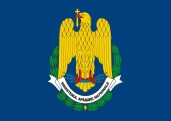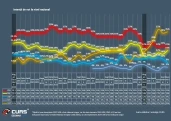Romania's economy will be among the ones to suffer the most from the consequences of the COVID-19 pandemic in the whole SEE region, due primarily to its high share of heavy industry and the related high reliance on international trade and investment, shows a SeeNews report titled "Covid -19 and SEE: The Initial Prospects to fight Off the Crisis."
The report covers 11 economies in the SEE region - Albania, Bosnia and Herzegovina, Bulgaria, Croatia, Kosovo, Moldova, Montenegro, North Macedonia, Romania, Serbia and Slovenia, and assesses their prospects to withstand the coronavirus crisis, both on the healthcare and the economic front, looking at 11 key indicators: containment measures, economic measures, GDP recovery, debt risk, industrial output, credit ratings, sectoral risk, GVA boosters, labor market, tax risk and exports risk.
Citing both the IMF and the World Bank, the report notes that as regards Romania's economic outlook, the country has no prospects of full recovery, at least until 2022, as it is facing a sharp and deep recession. This puts Romania in the group of SEE countries with the worst medium term GDP forecast, together with Slovenia, Croatia and Montenegro.
On the other hand, "the Romanian labour market is one of the best positioned in the whole SEE region due to the extremely low unemployment rate prior to the onset of COVID-19. As a consequence of this nearly full employment, however, the impact of the pandemic will be harder to be made up for and the unemployment figures, although still among the lowest in SEE, will not return to the 2019 level by the end of 2021. Recent IMF forecasts suggest that the average annual rate will climb to 10.1% this year from 3.9% in 2019, and then gradually slide back to 6% in 2021," reads the report.
In remarks on Romania's industrial output, the document states that the bulk of the downturn originated from the complete closure of the automotive industry, one of the pillars of the Romanian economy. "Manufacturing as a whole collapsed by 32.4% m/m, while mining and quarrying narrowed by a far more moderate 6.8%; electricity, gas and steam production, on the other hand, managed to break even with the previous month. The recuperation of the Romanian industry depends vastly on whether and when global supply chains are fully restored and when the European demand for industrial goods will reach its pre-pandemic level," it goes on to say.
The sectors of the Romanian economy identified as the most vulnerable to the pandemic consequences are manufacturing, construction, trade, tourism and transport, real estate and arts and entertainment, which contributed 69.4% of all corporate taxes paid in 2018, which ranks Romania in the group of medium performing SEE economies. Trade, tourism and transport is the largest taxpayer with 35%, slightly above the regional average of 33.2%, but manufacturing poses the greatest risk of corporate tax loss in comparative regional aspect, since it has the largest share in Romania's economy, compared with the other SEE countries, the document reads.
In considerations on the entire SEE region, the report notes that, as governments across the world started imposing lockdowns, it was clear that the SEE region had several advantages in the face of the incoming economic crisis, first because most of these countries had low public debt levels, which gave local governments the opportunity to implement comprehensive economic measures to support businesses and individuals without putting too much pressure on sovereign debts. On the healthcare side, most countries in SEE acted decisively and swiftly at the onset of the pandemic, imposing strict containment measures. Infection rates across the region were far below global levels at the time when countries across the globe started reopening their economies, but it remains to be seen whether these initial gains will be wiped out given the new spikes in cases in several SEE countries, the document states.
On the weak side, it notes that the majority of countries in the region rely heavily on sectors called "losing sectors" for the purpose of the report - these are the industries expected to bear the brunt of the economic crisis brought about by COVID-19.
There are also sectors that will emerge as "winners", the report states, but most of them currently represent too small a share of SEE economies' gross added value (GVA) to make a difference and counterbalance the negative effects in a meaningful way. This disproportion between losing and winning sectors makes the SEE region especially susceptible to sectoral risks and some economies are inevitably facing employment shocks as well as fiscal risks stemming from diminishing taxes.
SeeNews is an independent business intelligence provider with focus on emerging markets, delivering market research and analyses of key industries in Southeast Europe, and keeping track of the latest trends and developments.
































Comentează